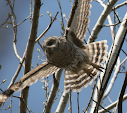After grabbing a bite to eat last evening I went in to the museum to meet some of the DFO folks and watch the presentation “One Hundred Years (and counting) of the Denver Museum of Nature and Science’s Ornithological Collection” by Dr. John Demboski the Curator of Vertebrate Zoology.
It was a very cool presentation considering that my expectations of a museum curator talking about a collection were tempered by experience. Sometimes they can be a bit like listening to a musician practice their music. The causal listener can't necessarily discern the details that are so important to the person who has poured their soul into the work. Dr. Demboski was not like that at all. He was a sociable speaker and shared his enthusiasm for the treasures in the collection and the potential that it holds for our and future generations. He did a great job of expressing to a lay audience that a collection at a museum does not just have to be static "old stuff".
Dr. Demboski tied in the early history of the museum with the levels of collected specimens over the decades. The peak growth periods were between the 1920s and 1940s, (think Indiana Jones era collectors). During the 1970s the additions to the collection essentially stopped, and no significant growth occurred. The historian in me, (my major in college) was going nuts - history and birding doesn't happen every day!
Of course Dr. Demboski has his priorities for the museum’s collection moving forward, and as expected he would like to reverse the downward trend of new specimen additions. He has a positive attitude towards technology and the non-traditional benefits that museum can have for the community at large.
These primarily relate to digitizing the collection catalogue, and the use of “deep freeze” preservation for tissue specimens to keep DNA samples available. These are not the stuffed, mounted displays we think of from our general public visits to similar museums, but are ironically of more value to researchers as they can contribute more to statistical analysis.
During the lecture I also learned that mounts and skins prepared in the early 20th century were all heavily coated in arsenic, and as such are technically hazardous materials. While they must now be treated with care to avoid human contamination the arsenic continues to do its job of preventing pests from infesting those mounts. The current practice for pest control in the collection is to monitor for any signs of infestation, and if a presence is detected – to deep freeze the specimen for a period of two weeks. This keeps the specimens pest and damage free, without the pesky side effects of poisoning or chemical contamination of the specimen.
This brings me back to the title of this post, some of the cool items that Dr. Demboski had on display for our group. There were study skins from the late 19th century of an Ivory-billed Woodpecker, and a similar and also feared extinct relative, the Imperial Woodpecker; as well as a Pileated for comparison. There was the sample that was studied to confirm the species status of the Gunnison Sage-Grouse and used in the documentation. Among the other interesting specimens was the 5000 year old semi-mineralized egg of the extinct Elephant Bird of Madagascar. It was literally the size of a larger than normal watermelon. The museum has two of the 16 known eggs from this species, which are the largest known eggs in the history of Earth. Very unique and very cool to have seen.
Dr. Demboski requested our assistance, and I will pass along the request to all of you to help the museum gather more samples. As the age of hunting expeditions to foreign lands has passed, and we now see more value in keeping a species alive in its habitat than stuffed in a collection warehouse, the sources of new specimens have diminished. However there is still a value in preserving those animals that have been found deceased. A current pool of specimens, and continued collections into the future will lay the groundwork for comparative research on habitat and diet change, and the continued viability of these collections in years to come. So, if you come across a deceased bird that was road-kill or suffered a window strike consider freezing it and contacting the Denver Museum of Nature and Science or a museum in your area.
In addition the DFO is also continuing its efforts towards getting Denver to join the Audubon Society's Lights Out campaign where owners of skyscrapers turn off their external illumination lights between 11pm and 5am during peak migration periods. Chicago's Lights Out Program has shown real results, with an estimated 10,000 building strikes avoided each year.
The program really capped a phenomenal afternoon of bird related activities.
Tuesday, February 24, 2009
Subscribe to:
Post Comments (Atom)


No comments:
Post a Comment